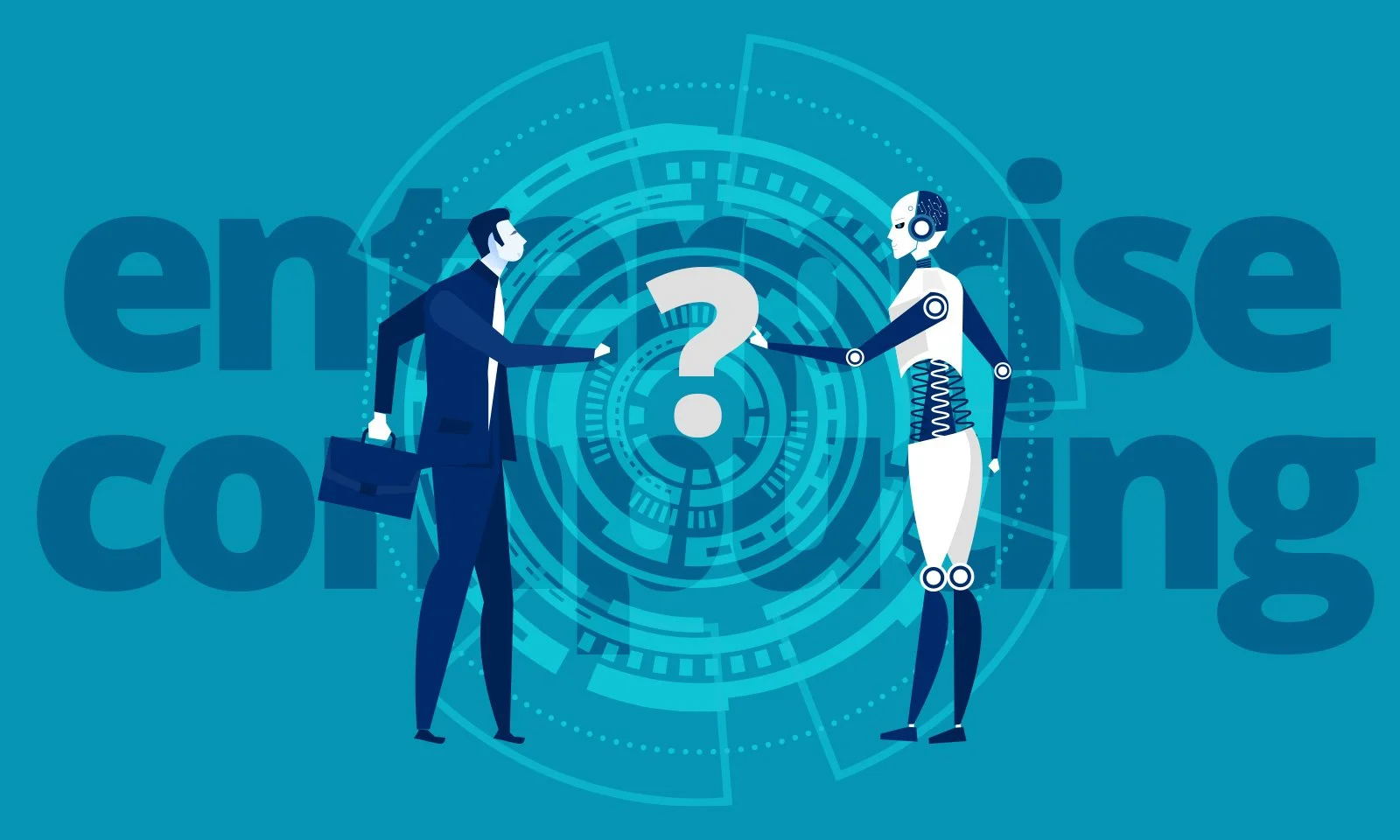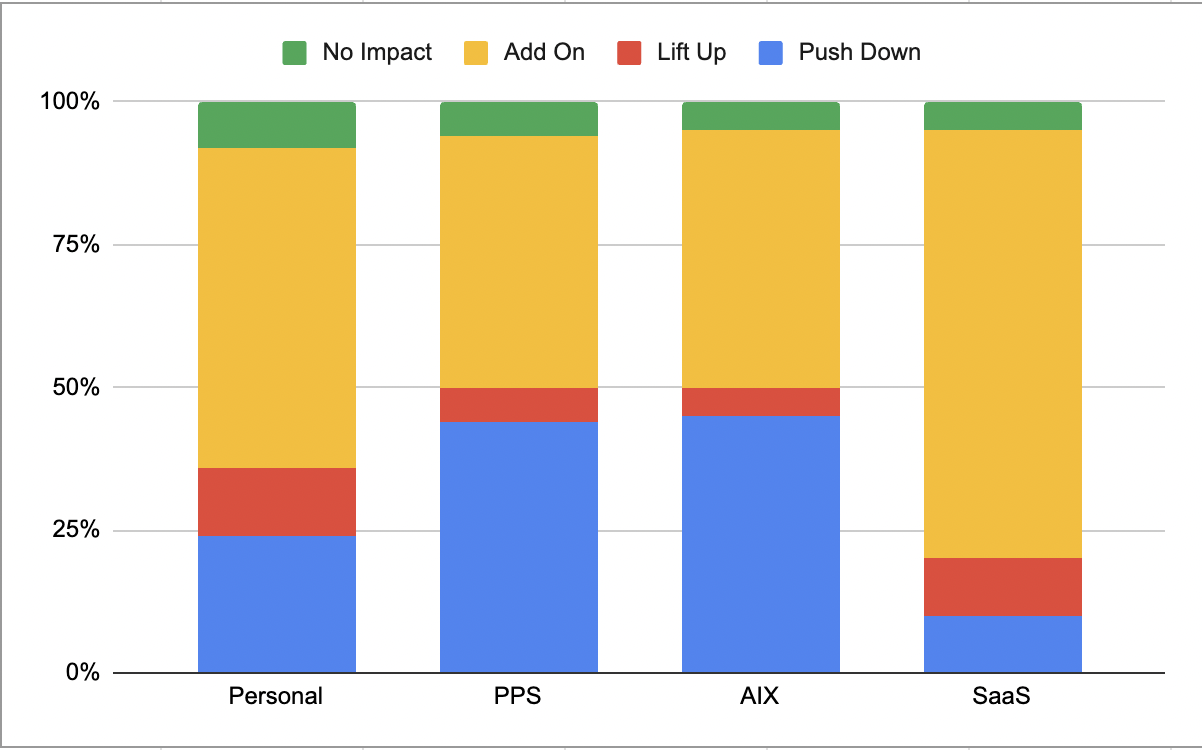Agents: add-ons or a new layer for enterprise computing?
Steven Forth is CEO of Ibbaka. Connect on LinkedIn
Agents are rapidly emerging as the dominant pattern for taking new generative AI functionality to market and for augmenting existing applications.
One open question is how this will impact the pricing of legacy SaaS applications. Opinion on this is sharply divided. We believe that this will push down prices of legacy applications and that agents will be priced at a premium. We described our reasoning for this in How agents are changing pricing. This is a minority opinion; the majority of people see agents as add-ons that provide incremental value. Could both opinions be true in different circumstances? Let’s explore.
How will agents impact pricing of legacy applications - poll results
In the week of July 7, 2025, we polled our LinkedIn community. We asked:
What impact will the emergence of agents have on legacy SaaS pricing?
a. Push prices down as legacy SaaS is a commodity
b. Lift legacy SaaS prices as agents make them more valuable
c. Agents will be added to the core platforms and priced accordingly
d. Agents will not impact pricing of core platforms
83 Responses: How will agents impact pricing of legacy applications, LinkedIn poll conducted July 9-12, 2025
A clear majority, 55.3% felt that “Agents will be added to the core platforms and priced accordingly.” Generally, this means that any agent will be priced at a small percentage of the total platform price, and that all the agents together will typically be less than 50% of the price. When buying a car, one does not expect the optional upgrades to cost more than the car.
Thirty percent of the respondents agreed that “Push prices down as legacy SaaS is a commodity”. In this case, value creation (and capture of value in price) shifts from the underlying application to agents that replace most of the user experience and are where value is created through the application of AI. The existing application remains, just as the hindbrain (the database) is still needed by the midbrain (the legacy application), but most of the activity is in the forebrain or neocortex (the AI agents). In this model, the agents could end up absorbing 90% or more of the total cost as the legacy app becomes a commodity.
Opinions varied sharply by group.
Seventy-five percent of people in the SaaS group felt that AI agents would be no more than add-ons. Only 10% felt that agents would push down SaaS prices, the same percent felt that agents would lift prices for legacy SaaS (by enhancing the value of existing functionality).
The picture is quite different for the AIX (people in the AI world) and the PPS (people who work in pricing). For both these groups, 45% of people think that AI agents will push down the price of legacy SaaS, and 45% feel that agents will be add-ons.
How will agents impact pricing of legacy applications, LinkedIn poll by respondent source, poll conducted July 9-12, 2025
What to make of all this? Perhaps everyone is right, and different patterns will play out in different contexts. One way to explore this is with scenario planning. We explore this in the following section.
Three scenario sets for the impact of agents on the pricing of legacy applications
In scenario planning, one works by establishing shared trends that are generally agreed on and then identifying critical uncertainties. The impact of AI agents on legacy SaaS applications could be seen as a critical uncertainty.
AI apps take over UX and become the locus for value creation and capture
orAI apps are used to enhance legacy applications, which remain the main context for user experience - AI apps provide incremental value as add-ons
Scenario planning works by combining two different critical uncertainties to generate a matrix of four possible futures (it is possible to combine more than two critical uncertainties, three gives 2 x 2 x 2 = 8 possible futures or four gives 16, but these are hard for humans to grok, perhaps as use of AI in this area advances we will see more scenarios combining multiple critical uncertainties).
In the following scenarios, we combine the Agent Role with three other critical uncertainties to generate three sets of scenarios.
Human-AI Collaboration
Integration Architecture
Organizational Change Velocity
It is possible that all twelve of these scenarios will emerge in different contexts. They are not mutually exclusive, and of course, many other futures are possible. It is worthwhile to identify. your own critical uncertainties and then combine them to generate scenarios.
Set 1 Agent Role x Human-AI Collaboration
In this set, we combine Agent Role (as defined above) with Human-AI Automation. Will our use of AI be to…
Augment workflows with a human in the loop, and in control
or willAI automate workflows which will take place without human intervention
The four scenarios play out as follows:
Augmented Workflows (Agents are used as add-ons to enable collaborative intelligence)
This is the co-pilot pattern emphasized by Microsoft and other companies with large, complex platforms. The AI is available on call to help with the work that is done by a human on the platform/application.
Automated Islands (Agents are added to existing software to enable full automation)
The existing platform or application uses AI and AI agents to automate existing workflows and processes.
Guided Orchestration (Agents lead collaborative work)
Humans call on a series of agents to execute workflows without ever interacting with the underlying legacy applications. More than one application may be leveraged in the background.
Autonomous Operations (Agents are able to execute on their own and have autonomy)
Agents execute and even design workflows, calling on other applications for data and services as necessary. The agents, through an orchestration system, are in control.
Scenario Set 2: Agent Roles x Integration Architecture
Despite decades of effort, or perhaps because of it, most enterprise software is inward-focused and only lightly integrated with other applications, generally through poorly defined and unstable APIs (I have done enough integration work to be sceptical of claims otherwise). Could agents help to change this?
Will agents
Connect workflows across applications and departments
or
Be limited to specific applications and the workflows they support
Connected Assistance (Agents as add-ons are part of a larger integrated system)
Agents act as assistants and carry context from one application to the next, making ingrated work easier, more efficient, and more effective.
Departmental Tools (Agents as add-ons are part of a siloed world)
Agents are limited to the applications they are built for and are focused on limited and specific workflows.
Enterprise Orchestration (Agents lead an Integrated System)
Agents play the leading role in connecting workflows and applications, deciding what data and applications to call and how to put them together.
Federated Agents (Agents lead in a siloed world)
Agents lead the execution of workflows and are generally able to execute without human intervention, but they remain locked in silos with limited ability to integrate or act on a company-wide context.
Scenario Set 3: Agent Role x Organizational Change Velocity
How quickly organizations adapt to an AI-driven agent-based approach will have a big impact on the role that agents can and will play. Will the adoption of AI agents be:
Rapid and all-encompassing
or
Gradual and incremental
Quick Wins (Agents as add-ons enabling rapid transformation)
Agents are dropped in and used as catalysts at critical points to demonstrate ROI and push forward an AI transformation.
Gradual Enhancement (Agents as add-ons used in a patchwork)
Agents are dropped in here and there as available in a patchwork and opportunistic approach.
Revolutionary Restructure (Agents lead the rapid restructuring of businesses and industries)
Agents are introduced in a systematic way across the organization and enable the reconfiguration of the entire company, extending to the restructuring of industries and sectors and new economic configurations.
Evolutionary Leadership (Agents are only gradually allowed autonomy, and change is gradual and piecemeal)
The overall organizational structure and business processes do not change, but control of the processes is slowly transferred from humans to agents as the agents demonstrate reliable capability.
What approach should you take?
One’s beliefs about the current and future role of agents will be coloured by one’s role.
People at agent-first companies will push towards scenarios where agents take the leading role and have more autonomy.
Legacy application vendors will work to position agents as assistants and keep the application at the forefront.
Implications for SaaS Vendors
Make two strategic decisions.
Are agents a disruptive or sustaining innovation for your application and in your space?
Disrupt your own application with an agent-first strategy
Enhance your application and use agents primarily as co-pilots and assistants or as the glue connecting things under the hood
Are agents going to be used within existing silos and value chains, or will they form new connections across silos and value chains?
Agents will add the most value within existing business processes and value chains.
Agents will add the most value by cross-connecting value chains, breaking down silos, and connecting business functions.
Implications for Buyers
Organizations will want to consider four key questions and decide on their strategy for agent adoption.
The experience their users want and expect - are they ready to work with agents, do they know how to manage a team of agents
The reliability and performance of the agents - how well the agents perform on benchmarks against the current process and how susceptible they are to hallucinations, drift, and error
Your mandate for transformation - AI and agents promise (or threaten, depending on your point of view) radical transformation, the companies that do this first will win, and this will be driven by agents and not legacy applications.
The fear of missing out (FOMO) - companies that do nothing or wait too long will be left behind, some adoption is AI and agents is critical, even if just as a defensive strategy.
For a complementary perspective, see the Bain and Co. Brief published Will AI Disrupt SaaS?
Sign up for the valueIQ beta to get early access
Navigating the new pricing environment brought by AI agents? Contact us @ info@ibbaka.com










